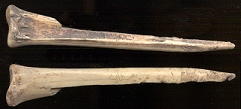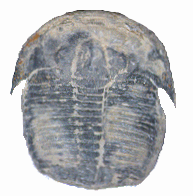

Repeat 50 times: Paleontologists are not archaeologists! Presented with a dinosaur bone, an archaeologist is no more—and perhaps less—knowledgeable than the average 10-year old. This is because archaeologists study human prehistory, not fossils—and some 65 million years separate the last known dinosaurs from the first humans.
On the other hand, fossils are where it's at for the paleontologist. Just don't expect one chosen at random to be able to pontificate on any particular dinosaur bone. There are some 3.5 billion years worth of fossils consisting of millions of species of bacteria, algae, plants, and animals out there—few of which are actually dinosaurs. Clearly, this is far more than any one person can be expert in.
Have a fossil you want identified? Head for your local university or
natural history museum, where you may get a bit of a shuffle while people try to figure
out whom to send you to. But most professionals can give you a ballpark identification
and pass you on to someone with more appropriate expertise. Who knows? That fossil
sitting on your desk just might be an unknown species!

Contributor: Arthur H. Harris, Laboratory for Environmental Biology, University of Texas at El Paso.
Desert Diary is a joint production of the Centennial Museum and KTEP National Public Radio at the University of Texas at El Paso.


Left: Two view of a prehistoric awl—in the realm of the archaeologist. Right: An extinct trilobite from the Cambrian Period—an object of study for a paleontologist.
Boardman, R. S., A. H. Cheetham, and A. J. Rowell, editors. 1987. Fossil Invertebrates. Blackwell Science, Cambridge, MA, 713 pp.
Benton, M. J. 1997. Vertebrate Palaeontology. 2nd ed., Chapman and Hall, London, 452 pp.